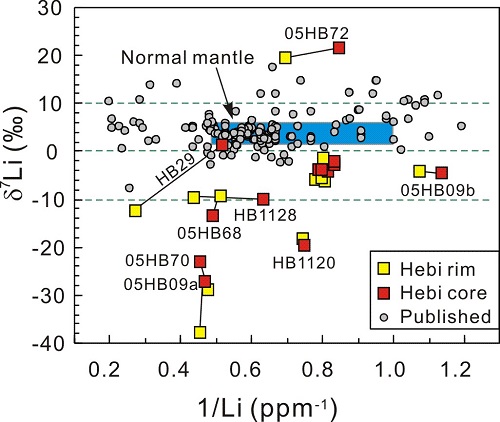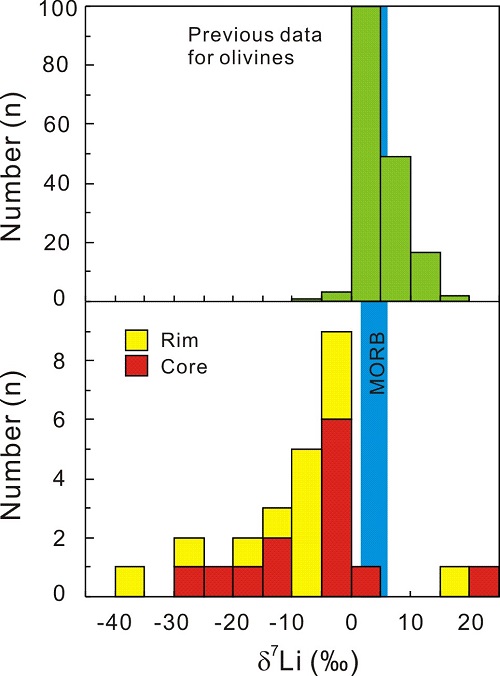Lithium has proven to be an important geochemical tracer for fluid-related processes in the Earth’s surface as well as crust-mantle recycling because of its moderate incompatibility during mantle melting, strong fluid mobility, and the large mass fractionation, with up to 80‰ variation of 7Li/6Li in terrestrial samples. The Li isotopic heterogeneity in the mantle caused by fluid/melt-rock interaction can be rehomogenized by diffusion over geologically short time periods due to the fast diffusion of Li, and thus the mantle is broadly characterized by homogeneous Li isotope composition. However, several studies have suggested the existence of abnormal δ7Li in the mantle, such as high δ7Li (up to +7.9) of HIMU lavas and low δ7Li (lower than -7.0) of mantle-derived minerals and lavas, which are considered to result from isotope fractionation during the dehydration of subducted oceanic crust. To date, the data on abnormal δ7Li are mainly recorded from indirect samples of the mantle or directly on clinopyroxene separates in peridotites, although the latter are susceptible to recent diffusive fractionation of Li isotopes during the entrainment and transportation of the xenoliths by host magma due to the much faster diffusion of Li in pyroxene than in olivine. In contrast, the Li isotope compositions in the cores of large olivine grains from peridotite xenoliths, which represent direct samples of the upper mantle, provide more robust signature of the lithospheric mantle.
In this study, Tang et al. reported the anomalous Li isotope compositions of olivines in a suite of peridotite xenoliths from the Hebi locality in the central North China Craton, one of the world’s oldest continental nuclei. The δ7Li in the cores of olivines from the Hebi high-Mg# peridotites (Fo>91) show extreme variation from -27 to +21, in marked deviation from the δ7Li range of fresh MORB although the Li abundances of the olivines are within the range of normal mantle (1-2 ppm). The Li abundances and δ7Li characteristics of the Hebi olivines could not have been produced by recent diffusive-driven isotopic fractionation of Li and therefore the δ7Li in the cores of these olivines record the isotopic signature of the subcontinental lithospheric mantle. These data demonstrate that abnormal δ7Li may be preserved in the ancient lithospheric mantle as observed in this study, which suggest that the subcontinental lithospheric mantle has experienced modification of fluid/melt derived from recycled oceanic crust.
The above results were published by Scientific Reports, an open access publication from the publishers of Nature (Tang et al. Abnormal lithium isotope composition from the ancient lithospheric mantle beneath the North China Craton. Scientific Reports, 2014, 4: 4274. Doi: 10.1038/srep04274).

Figure 1. Variation of δ7Li with Li abundances of olivines in the Hebi xenoliths compared to the published data for olivines from worldwide peridotites. The field for normal mantle is based on the compositions of relatively pristine olivines and fresh MORB.

Figure 2. Histograms of δ7Li for olivines in the Hebi xenoliths and those from worldwide peridotites.
Scientific Reports(Tang et al. Abnormal lithium isotope composition from the ancient lithospheric mantle beneath the North China Craton. Scientific Reports, 2014, 4: 4274. Doi: 10.1038/srep04274)Link

 Print
Print Close
Close

